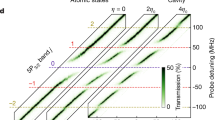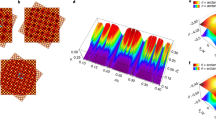Abstract
Multi-cavity photonic systems, also known as photonic molecules, exhibit multi-well potentials that may prove useful for advanced quantum and nonlinear optics1,2,3,4. A key phenomenon arising in double-well potentials is the spontaneous breaking of inversion symmetry, with a transition to two localized states in the wells, which are mirror images of each other. Although a few theoretical studies have addressed mirror-symmetry breaking in micro- and nanophotonic systems5,6,7, no experimental evidence has been reported to date. Here, we demonstrate spontaneous mirror-symmetry breaking through a pitchfork bifurcation in a photonic molecule composed of two coupled photonic-crystal nanolasers. The coexistence of localized states is shown by switching them with short pulses. This offers exciting prospects for the realization of ultra-compact, integrated, scalable optical flip-flops. Analysis suggests that such symmetry breaking should be possible with a small number of intracavity photons and is thus suitable for quantum correlation devices.
This is a preview of subscription content, access via your institution
Access options
Subscribe to this journal
Receive 12 print issues and online access
$209.00 per year
only $17.42 per issue
Buy this article
- Purchase on Springer Link
- Instant access to full article PDF
Prices may be subject to local taxes which are calculated during checkout




Similar content being viewed by others
References
Abbarchi, M. et al. Macroscopic quantum self-trapping and Josephson oscillations of exciton polaritons. Nature Phys. 9, 275–279 (2013).
Dousse, A. et al. Ultrabright source of entangled photon pairs. Nature 466, 217–220 (2010).
Gerace, D., Türeci, H. E., Imamoglu, A., Giovannetti, V. & Fazio, R. The quantum-optical Josephson interferometer. Nature Phys. 5, 281–284 (2009).
Liew, T. C. H. & Savona, V. Single photons from coupled quantum modes. Phys. Rev. Lett. 104, 183601 (2010).
Rodrigues, A., Kevrekidis, P., Cuevas, J., Carretero-González, R. & Frantzeskakis, D. in Spontaneous Symmetry Breaking, Self-Trapping, and Josephson Oscillations (ed. Malomed, B. A.) 509–529 (Springer, 2013).
Maes, B. et al. Switching through symmetry breaking in coupled nonlinear micro-cavities. Opt. Express 14, 10678–10683 (2006).
Bulgakov, E. N. & Sadreev, A. F. Symmetry breaking in photonic crystal waveguide coupled with the dipole modes of a nonlinear optical cavity. J. Opt. Soc. Am. B 29, 2924–2928 (2012).
Golubitsky, M., Schaeffer, D. G. & Stewart, I. Singularities and Groups in Bifurcation Theory Vol. 2 (Springer, 1988).
Endres, M. et al. The ‘Higgs’ amplitude mode at the two-dimensional superfluid/Mott insulator transition. Nature 487, 454–458 (2012).
Zibold, T., Nicklas, E., Gross, C. & Oberthaler, M. K. Classical bifurcation at the transition from Rabi to Josephson dynamics. Phys. Rev. Lett. 105, 204101 (2010).
Liu, M., Powell, D. A., Shadrivov, I. V., Lapine, M. & Kivshar, Y. S. Spontaneous chiral symmetry breaking in metamaterials. Nature Commun. 5, 4441 (2014).
Green, C., Mindlin, G. B., D'Angelo, E. J., Solari, H. G. & Tredicce, J. R. Spontaneous symmetry breaking in a laser: the experimental side. Phys. Rev. Lett. 65, 3124–3127 (1990).
Kevrekidis, P. G., Chen, Z., Malomed, B. A., Frantzeskakis, D. J. & Weinstein, M. I. Spontaneous symmetry breaking in photonic lattices: theory and experiment. Phys. Lett. A 340, 275–280 (2005).
Hodaei, H., Miri, M.-A., Heinrich, M., Christodoulides, D. N. & Khajavikhan, M. Parity-time-symmetric microring lasers. Science 346, 975–978 (2014).
Jona-Lasinio, G., Presilla, C. & Toninelli, C. Interaction induced localization in a gas of pyramidal molecules. Phys. Rev. Lett. 88, 123001 (2002).
Malomed, B. A. Spontaneous Symmetry Breaking, Self-Trapping, and Josephson Oscillations (Springer, 2013).
Liu, L. et al. An ultra-small, low-power, all-optical flip-flop memory on a silicon chip. Nature Photon. 4, 182–187 (2010).
Nozaki, K. et al. Ultralow-power all-optical ram based on nanocavities. Nature Photon. 6, 248–252 (2012).
Coullet, P. & Vandenberghe, N. Chaotic self-trapping of a weakly irreversible double bose condensate. Phys. Rev. E 64, 025202 (2001).
Akahane, Y., Asano, T., Song, B.-S. & Noda, S. High-q photonic nanocavity in a two-dimensional photonic crystal. Nature 425, 944–947 (2003).
Portalupi, S. L. et al. Planar photonic crystal cavities with far-field optimization for high coupling efficiency and quality factor. Opt. Express 18, 16064–16073 (2010).
Tran, N.-V.-Q., Combrié, S. & De Rossi, A. Directive emission from high-q photonic crystal cavities through band folding. Phys. Rev. B 79, 041101 (2009).
Haddadi, S. et al. Photonic crystal coupled cavities with increased beaming and free space coupling efficiency. Appl. Phys. Lett. 102, 011107 (2013).
Caselli, N., Intonti, F., Riboli, F. & Gurioli, M. Engineering the mode parity of the ground state in photonic crystal molecules. Opt. Express 22, 4953–4959 (2014).
Haddadi, S. et al. Photonic molecules: tailoring the coupling strength and sign. Opt. Express 22, 12359–12368 (2014).
Chalcraft, A. R. A. et al. Mode structure of coupled L3 photonic crystal cavities. Opt. Express 19, 5670–5675 (2011).
Caselli, N. et al. Antibonding ground state in photonic crystal molecules. Phys. Rev. B 86, 035133 (2012).
Ishii, S., Nakagawa, A. & Baba, T. Modal characteristics and bistability in twin microdisk photonic molecule lasers. IEEE J. Sel . Top. Quantum Electron. 12, 71–77 (2006).
Chen, C.-H. et al. All-optical memory based on injection-locking bistability in photonic crystal lasers. Opt. Express 19, 3387–3395 (2011).
Ruter, C. E. et al. Observation of parity-time symmetry in optics. Nature Phys. 6, 192–195 (2010).
Shambat, G. et al. Electrically driven photonic crystal nanocavity devices. IEEE J. Sel . Top. Quantum Electron. 18, 1700–1710 (2012).
Acknowledgements
The authors thank A. Amo, J. Bloch, S. Barbay, J. Dudley, N. Treps, J. Tredicce, K. Bencheikh and A. Aspect for comments. This work was supported by the Centre National de la Recherche Scientifique, the Agence Nationale de la Recherche (ANR) (ANR-12-BS04-0011) and the RENATECH network.
Author information
Authors and Affiliations
Contributions
A.L. and A.M.Y. conceived and designed the experiments. P.H. and S.H. performed the experiments. F.R., G.B. and I.S. fabricated the samples. P.M. provided technical assistance. A.M.Y. performed theoretical analysis and numerical simulations. A.L., P.H. and A.M.Y. co-wrote the paper.
Corresponding author
Ethics declarations
Competing interests
The authors declare no competing financial interests.
Supplementary information
Supplementary information
Supplementary information (PDF 2209 kb)
Rights and permissions
About this article
Cite this article
Hamel, P., Haddadi, S., Raineri, F. et al. Spontaneous mirror-symmetry breaking in coupled photonic-crystal nanolasers. Nature Photon 9, 311–315 (2015). https://doi.org/10.1038/nphoton.2015.65
Received:
Accepted:
Published:
Issue Date:
DOI: https://doi.org/10.1038/nphoton.2015.65
This article is cited by
-
Nonlinear topological symmetry protection in a dissipative system
Nature Communications (2024)
-
Experimental observation of spontaneous symmetry breaking in a quantum phase transition
Science China Physics, Mechanics & Astronomy (2024)
-
Normal mode analysis in multi-coupled non-Hermitian optical nanocavities
Scientific Reports (2023)
-
Spontaneous symmetry breaking and ghost states in two-dimensional fractional nonlinear media with non-Hermitian potential
Communications Physics (2023)
-
Tracking exceptional points above the lasing threshold
Nature Communications (2023)



